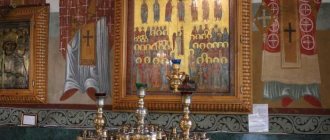The Day of St. George the Victorious, which is popularly also called Yuri of the Spring and Yegoryev's Day in 2021 in Ukraine is celebrated on May 6. St. George's Day is one of the most revered holidays in Christianity. Orthodox Christians often turn to Saint George for help, pray for the health of loved ones and protection from enemies.
The days of remembrance of the Great Martyr George the Victorious in 2019 are celebrated several times in the church calendar:
- April 23 (May 6),
- November 26 (December 9),
- November 3 (16),
- November 10 (23).
Day of St. George the Victorious (Yuri): history of the holiday
- According to the old scripture, the Holy Great Martyr George lived in 284-305. during the time of Emperor Diocletian. He was the son of rich and pious Christian parents. When he grew up, he entered military service, during which he stood out from the rest with his valor and intelligence. And thanks to his devotion and diligence, he became Diocletian’s favorite, and over time earned the title of commander of a thousand.
- According to legend, when George once witnessed an inhuman trial of Christians, he distributed his property to the poor, exposed the king’s lies and began to profess Christianity. He was decisive in his actions and harsh in his statements, for which he had to suffer. Despite the fact that he was a great warrior, he was still strongly asked to renounce Christianity, he not only did not refuse, but also survived torture. George was tortured for seven days, and each time he was miraculously healed. And on the eighth day he was executed. Saint George suffered martyrdom for Christ in 303, in Nicomedia.
- The life of the Holy Great Martyr George became an example of the irreconcilable victory of the forces of Good over the forces of Darkness. Watching his miraculous healing, many people saw the power of faith and began to accept his faith - Christianity. Also, in honor of the great martyr warrior, the Order of St. George was even established in the army.
Veneration of a saint in Rus'
Since ancient times, peasants have revered St. George the Victorious under other names - Yuri, George. When, during the period of serfdom, the Code of Law established the annual right of peasants to leave one owner to another, the phrase “St. George’s Day” and the associated sarcastic saying “here’s your grandmother and St. George’s Day” became common among the common people. It is a kind of expression of frustration, regret and resentment over the collapse of built-up hopes. The reason for this was the short period of the established exit period (a week before Yegor and a week after), during which the majority of forced laborers simply did not have time to decide to leave the landowner, which they regretted throughout the next year.
Day of St. George the Victorious (Yuri): traditions
On this day, Orthodox Christians attend church or read prayers of thanks at home. On May 6, many mothers ask St. George for a blessing for their sons, especially for those young men who are serving in the army, taking part in hostilities, or living far from their father’s home. On this day, it was customary for our ancestors to give gifts to husbands, grandfathers and brothers, and also to pray that their lives would be long and joyful.
Nice day of the year
Every year on May 6, the Orthodox Church celebrates a big holiday - the day of remembrance of St. George the Victorious. The veneration of this saint in Russia is of particular importance. And in the center of the coat of arms and on the coins there is still an image of his feat.
Special veneration of the Victorious in Rus' has been going on since 1030. This happened after the victory of Yaroslav the Wise over the miracle, when he founded the Yuryevsky Temple not far from Novgorod. And six years later, after the victory over the Pechenegs, the prince began construction of the monastery of St. George in Kyiv. The consecration of the St. George Church on November 26 became one of the first ancient Russian holidays, just as we honor the day of the death of St. George itself - in May.
Our contemporaries saw some symbolism in the fact that it was on the day of memory of St. George the Victorious that the final defeat of Nazi Germany took place. And the surrender itself on May 8, 1945 was also accepted by Georgy, Marshal Zhukov, who had previously led a large number of victorious battles in this terrible war. Therefore, the day of St. George the Victorious is now doubly revered.
Day of St. George the Victorious (Yuri): signs
Yegory has come - and spring will not leave. Yegory is one of the variants of the name Georgy, just like Yuri. This day is truly considered the day of the final entry of spring into its rights. It is believed that the cold will not bother us for a long time now.
- People said that if dew falls on May 6, then on May 22, on St. Nicholas the Wonderworker, there will be so much grass that all the cattle will be fed. On this day, the last supplies of winter feed were fed to cows, goats and horses. Now it will be possible to take the cattle out to pasture. From this moment on, nature itself will begin to feed all living creatures.
- A clear, windless morning on May 6 - early sowings will be successful and there will be a rich harvest.
- Warm weather in Yuri - summer will come soon.
- If dew appears, there will be a good harvest of millet.
- If it snows or hails, or frost is noticeable on the trees, the buckwheat will grow.
- If the night from May 6 to 7 is very warm, the bread will have time to ripen before the first frost.
- On this day you can observe the behavior of mosquitoes; if they gather in flocks, wait for warmer weather.
- If the water level in the rivers has increased or they have overflowed heavily, there will be a lot of grass on St. Nicholas Day (May 22).
- Heavy rain on May 6 - a lot of grass will grow.
- A damp towel was hung out the night before May 6th. If it dries out in the morning, the cucumber harvest will be rich.
Spear piercing a snake
St. George the Victorious performed many miracles. Legends and stories were written about them and about his brave and truly courageous deeds. One incident served as the plot for a painting known to almost everyone, which depicts George sitting on a horse and piercing a snake with his spear. According to a long-standing legend, in Beirut, in one of the lakes, there lived a large snake, from which the local residents had no peace. To prevent him from causing even more trouble, they brought him a child every day. And only Saint George the Victorious was able to slay this snake and save the inhabitants of this area from trouble.
Such a wonderful story of George’s victory became a symbol that good will triumph over evil.
Prayer to Saint George the Victorious
The prayer to Saint George the Victorious is read with the goal of being healed of ailments and getting rid of enemies, envious people and evil people.
O all-praised holy great martyr and wonderworker George! Look upon us with your quick help and beg God, the lover of mankind, not to judge us sinners according to our iniquities, but to deal with us according to His great mercy. Do not despise our prayer, but ask us from Christ our God for a quiet and godly life, mental and physical health, fertility of the earth and abundance in everything, and may we not turn the good things given to us by you from the all-generous God into evil, but into the glory of the holy name Him and in glorification of your strong intercession, may He grant our Orthodox people victory as adversaries and may He strengthen us with irreplaceable peace and blessing. May His angel protect us saints more generously with a militia, so that we, upon our departure from this life, may be delivered from the wiles of the evil one and his difficult airy ordeals, and may present ourselves uncondemned to the throne of the Lord of glory. Hear us, passion-bearing George of Christ, and pray for us unceasingly to the Trinitarian Lord of all God, so that by His grace and love for mankind, with your help and intercession, we may find mercy with the Angels and Archangels and all the saints at the right hand of the just Judge, and we may glorify him with the Father and Holy Spirit, now and ever and unto ages of ages. Amen.
His life path
Let's remember who George was in his ordinary life. He was raised by deeply religious parents. From childhood, the boy was distinguished by nobility, beauty, righteousness, and courage. When he grew up, through his merits he earned the right to be the right hand of the emperor, who treated him well.
But it so happened that all the forces of power that then existed in Rome were thrown into the destruction of Christians and the revival of pagan customs. Saint George could not tolerate such treatment of people and took action. This great man distributed all his property to those in need. He, trying to console the people who accepted the Lord in his heart, challenged the Roman emperor. He did not renounce his faith, which is why he was subjected to torment and torture. This happened constantly: they broke his bones, burned him, pierced his feet with nails... And every time the Lord healed him. The emperor, recognizing his helplessness, ordered George's head to be cut off.
What does the icon of St. George mean?
Thanks to his boundless courage, the man was able to quickly move up the career ladder and reach a high-ranking position. However, even his high rank did not save his mother from death. The woman passed away when the guy was about twenty years old. And at the same time, significant Christian persecution swept across the country.
George himself, who adhered to Christianity, did not want to hide before the emperor, so he decided to distribute his rich inheritance to those in need and go personally to the head of the state to confess his religion.
This turn of events did not please the emperor, who began to first persuade and then torture the brave warrior. At this time, one of the miracles happened, which immediately became public knowledge.
During one of the tortures, George simply crossed himself, and in the temple of Apollo, which was the abode of pagans, all the idols suddenly fell. The emperor could not forgive such a saint, so he ordered to quickly get rid of the one who sows doubts among the people.
It is noteworthy that the emperor’s wife listened to George’s words and also converted to Christianity, for which she also paid with her head.
When do we celebrate?
Often people who are not very knowledgeable about church holidays have a question: what date is the feast of St. George the Victorious? The veneration of this man in Russia has become very important. To this day, the image of his feat is depicted on coins and in the center of the coat of arms.
George is remembered as an intercessor of Christians, a generous, kind and decent hero, and he was also a true righteous man. Experiencing so much suffering, he did not think for a second about renouncing his faith. It is this act of his that serves as a kind of guiding star, a real example for all Orthodox people. And the image of George piercing a serpent with a spear, familiar to almost everyone, is directly related to the feat thanks to which a large number of people were converted to Christianity.
It is May 6th that is the Orthodox holiday of St. George the Victorious, which many people know about. Those who consider themselves to be true Christians.
Don't touch the comb!
It has already become clear that the holiday of St. George the Victorious is considered really big. What should you not do on this day?
They say that on such a great holiday you should not use combs, combs, scissors and brushes. And old people also mention that these objects should be hidden further away so that they do not catch the eye. This example has two not very good consequences.
Firstly, if someone decides to cut their hair or simply comb their hair, the hair will become weaker and gradually begin to fall out.
Secondly, there is an opinion that by acting contrary to the rules, you can lose your wet nurse, that is, a cow. The animal will not die, but the calves will no longer be born, therefore, there will be no milk.
History of the life of St. George
The future saint was born into a fairly wealthy family, without knowing any financial need. His mother was of blue blood, and his father was famous for his valor during military operations. It was the pope’s career that probably influenced the choice of the professional path of the young righteous man.
It is believed that he was born around the second century in the territory of modern Turkey. But after his father died, he had to move with his mother to her small homeland. There the woman ran the business, and George built a brilliant military career, while not forgetting to follow the Word of God.










